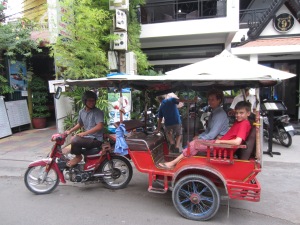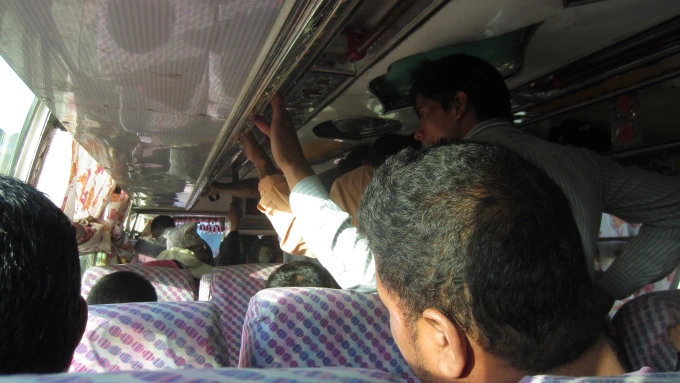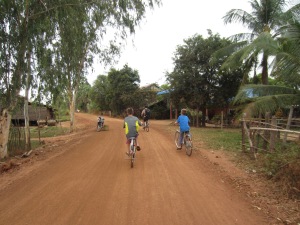We spent five days hiking into the remote Tsum Valley as part of our larger trek around the Manaslu Circuit. The Tsum Valley runs through a protrusion of Nepalese territory surrounded by Tibet on three… More
Village life
We had the opportunity to observe Nepalese village life close up during our time in Betahani just outside the Bardia park boundary. Our other observations of village life have been in the high altitude areas of Langtang and from the windows of various vehicles as we whiz by on the roads. From what we can see, village life in Nepal revolves around food production and preparation.
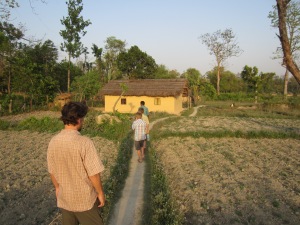

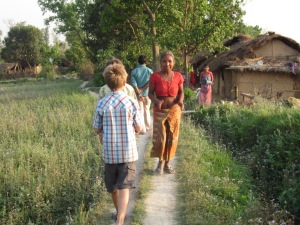

In the Terai, the lentil and wheat harvests are in full swing. In other regions, the wet rice crop is in the ground in anticipation of the coming monsoon rains required to irrigate this water-intensive crop. All of these staples require drying and hulling to remove husks and make the grains ready for consumption.
We’ve observed three methods of hulling. Mechanized hulling is rare, but it is available for those farmers who can afford to pay the itinerant hulling machine operator who hauls his rig from village to village this time of year. (Other forms of mechanized farming, such as the use of tractors or rototillers to prepare the soil, are equally rare in Nepal and every other country we’ve visited with the exception of Thailand.) It is less expensive to have a pair of oxen stomp over your rice, wheat or lentils for hours until the grains have been broken loose from their hulls. We observed this method in several villages. Dried lentil stalks are piled on the hard-packed earth while the beasts tread a slow, tight, repetitive circle. When that stage is finished, the husk-less grains must be gathered up by hand and separated from various non-grain items and debris. The resulting small basket of lentils looks paltry against the effort required, and makes one thankful for the rice and beans aisles in our grocery stores. The final hulling method is the “road hull” in which sheaves of wheat are placed on the road in anticipation of large trucks and buses passing by to do the work. The heavy vehicles provide a free hulling service, but it is a dangerous technique (especially for the woman [yes, this is women’s work here] tasked with gathering up the grains at the end of the day), and it makes you wonder about the “natural” ingredients you might find in your bread.
Having seen the ox and truck methods in action I will no longer wonder “how did this rock get in my rice?”, and I will take more seriously the suggested first step in most lentil recipes: rinse lentils.

(As a side note, one hazard of growing crops next to a huge protected area full of elephants, like Bardia National Park, is that elephants love to eat those crops. Twice during our time in Betahani we heard large crowds yelling and screaming in the middle of the night. The entire village had come out to scare off a rogue elephant who’d found his way into the wheat fields. The next day we noticed a list of warnings posted in our room, all of which addressed the dangers of wandering outside at night to see what the commotion was about.)
Food preparation, which often requires a heat source, is another oft-observed activity. Not just the cooking, but the acquisition of fuel. Coming across a shambling pile of sticks and branches is a regular occurrence on the roads and trails of Nepal. These turn out to be either very young or very old people hauling bundles of firewood back to the cook stoves. Firewood is scarce in most parts of the country, so alternative fuel sources have been developed. On the Terai we saw what looked like long mud bricks in regular stacks drying along the side of the road. These turned out to be the Nepalese version of Duraflame firelogs consisting of animal dung and the chaff extracted from the hulling processes described earlier. In other places, straight dung (yak chips) augments firewood as fuel for heating and cooking. But our favorite fuel source is the up and coming use of biogas. Animal and human waste are stirred up and placed in a digester under an airtight dome (usually buried underground). As these wastes decompose, gases are released and captured in the dome. Enough pressure is created by the gravitational push of additional dung coming down the shoot to push the gas out a valve at the top of the dome and to an efficient, single burner cook stove. These systems are being installed at the household level throughout the country. Of course the use of poop to create gas to cook food is intriguing, especially for a 9 and 12 year old boy, and the talk of developing other ways to generate and capture biogas has been seemingly endless.
A final note on the importance of food in village life has to do with livestock. Animals are everywhere in Nepal: in the countryside and in the cities. Water buffalo are used for traction (hauling carts and tilling fields), donkeys and horses as pack animals (especially in the roadless mountain areas), cows and cow/yak hybrids are sources of milk, goats are also sources of milk and of meat, pigs are here (although they are less common in Nepal than in Southeast Asia), and chickens run wild (in fact the domesticated chicken has its origins in the wild chicken of northern India and the Terai) as do dogs (which don’t appear to be a food source here, unlike other countries we’ve visited on this trip). Tending these creatures is a focal point in the life of many villagers.
Below a few pictures of these beasties.
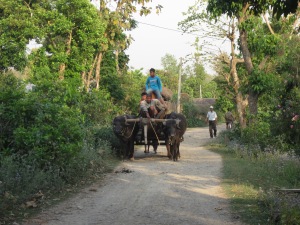
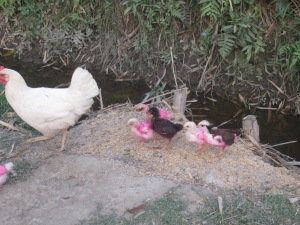
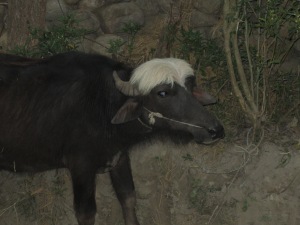
Temples of Kathmandu Valley
Temples, other sacred structures and religious iconography are everywhere in Nepal. It would take months of determined sightseeing just to visit all of the temples in the Kathmandu Valley and many years of study to understand them fully. It would be easy to overdose on religious studies and temple touring, so we’ve engaged in both on only a limited basis. But religion plays such a central role in this society that, not only is it an unavoidable part of any trip to Nepal, one cannot understand Nepal without first trying to understand the two main religions here: Hinduism and Buddhism. This entry tries to give an account of some of what we’ve seen of these religions in the architecture and statuary in the Kathmandu Valley.
We started our time in Kathmandu Valley in the Tibetan Buddhist neighborhood of Boudha within sight of the huge Bodhnath Stupa. This stupa has attracted Tibetan refugees and travelers over many centuries and is a centerpiece of the exiled Tibetan Buddhist community in this country. For us it was a first introduction to the religious foundations of Nepal.

Two things became immediately apparent as we walked around this stupa in the late afternoon of our first day (always clockwise with the stupa on our right!). The stupa (originally constructed around AD 600) is still a focal point of current religious practice. Unlike many of our European churches which have been abandoned by the faithful even while swarmed by tourists, this stupa, and all of the other temples we visited, are in daily use by their respective adherents. The other thing that struck us was the incorporation of icons that we did not understand as being “purely” Buddhist. The Buddha eyes on the tower below the spire and the five-colored prayer flags blowing in the breeze are both identifiable to even the minimally initiated as Buddhist icons or objects. But there at the base of the stupa, in fact incorporated into the structure of the stupa, was a temple dedicated to Hariti. Who is this Hariti? we wondered. The goddess of smallpox, we were told. When we ran into Hariti several weeks later at the Swayambhunath Stupa we were told she is the goddess of fertility and a protector of children. Upon further investigation, it turns out that the story of Hariti (aka Ajimadya or Sitalamaju) is a long one starting in what is now Iran, and her relationship with Buddhism is complex. (We’ve come to find that long, complex stories are the norm here!)
The next question that came to mind was whose goddess of smallpox and fertility? Hariti, it turns out, was a non-Buddhist who was instructed by Buddha about the value of compassion. As a result, she changed her evil ways (killing children) and became a guardian of the Buddha’s doctrine. And yet there at the base of one of the largest and most important Buddhist structures in Asia, Hindus, among others, were praying to Hariti. This same scene repeated itself several weeks later when we visited the Swayambhunath temple complex, a chaotic jumble of Hindu and Buddhist structures and iconography (centered on the Buddhist Swayambhunath Stupa but also including a prominent Hariti Temple) at the top of a high hill west of central Kathmandu.
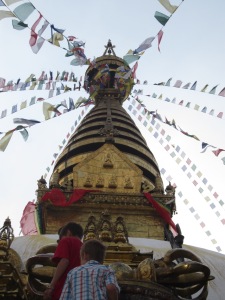


In this last photo, one might expect a Shiva lingam (a Hindu symbol) atop the yoni, but there sits Buddha.
These two initial impressions — religious structures in regular daily use and a complex intermixing of Buddhist and Hindu iconography and architecture — became enduring themes as we visited or came across the artifacts of religion throughout our first month in Nepal.
The Bodhnath Stupa was just the beginning. The next day we visited the Pashupatinath temple complex as the Hindu faithful prepared for the Maha Shivaratri festival (about which we reported briefly in an earlier post), and here too the intermixing of the two religions was apparent with Buddhist icons appearing here and there and a few of the hermit meditation caves set aside for Buddhist devotees.
The notion of daily use, the deep incorporation of religion into the regular routine of the Nepalese and the mixing of Hinduism and Buddhism were on display during a stroll through a residential/commercial district of old Kathmandu during which we encountered a 15th Century Buddhist stupa across from a temple dedicated to Shiva. One block on we hit another stupa before passing an altar to Ganesh and then a 9th Century stone relief of Shiva and Parvati, then another Hindu temple with a carved Garuda, and, turning the corner, a short, unremarkable 5th Century standing Buddha statue tucked inconspicuously between a hardware store and the neighboring business. All this in the first five minutes of a casual stroll through busy, narrow streets with secular life churning around the ancient and the sacred. We walked on for another 30 minutes through a similar landscape before being driven inside by an unusual cloudburst for a cup of milk tea.
The constant presence of religious objects repeats itself throughout the Kathmandu Valley, an area stretching approximately 15 km north to south and 30 km east to west and consisting of many smaller towns and neighborhoods. Boudha and Dhulikhel are two we’ve written about. We also visited Panauti at the confluence of the sacred Roshi and Pungamati Rivers (yes, more sacred rivers) and Swayambhunath, the “Monkey Temple”, mentioned above. Finally, we spent one night in the former city state kingdom of Bhaktapur with its famous Durbar (or Palace) Square and its many other plazas surrounded by temples to the various gods. Our travels within the Kathmandu Valley only scratched the surface in this densely populated and historically rich part of Nepal. In all of these places it is difficult to walk ten feet without passing a Ganesh figure smeared with red paste, or a Buddhist stupa surrounded by prayer flags. And with the panoply of gods and other characters (demons, various incarnations of each god, their children and consorts, and their animal companions or vehicles [vahana]), it is often difficult to understand who is being worshiped and for what purpose. Some gods are well-known and the obvious object of worship if you know what to look for (a trident is Shiva’s weapon of choice, a Garuda is Vishnu’s vahana), but others are a bit more obscure. For example, the toothache god hiding in an old snag of wood covered with coins that had been nailed to the misshapen tree trunk. The fact that his little shrine was located in a district with lots of dentist offices didn’t make his purpose that much more obvious to the uninitiated. For what is, in some sense, a one-man show, the Buddhist system also includes a surprisingly large number of characters, many of them borrowed from the older Hindu system. (This intermingling includes the belief among some Hindus that Buddha is the ninth incarnation or avatar of Vishnu.)
Below are a few more photos of religious buildings and objects.
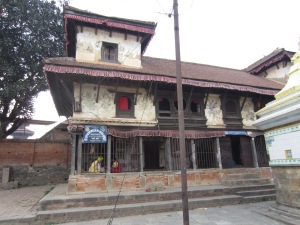

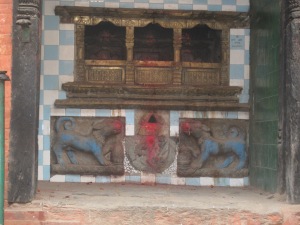

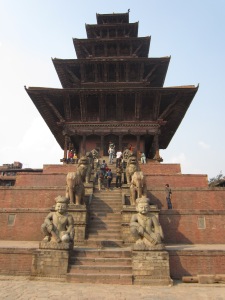
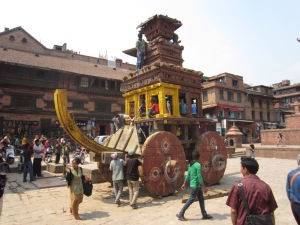
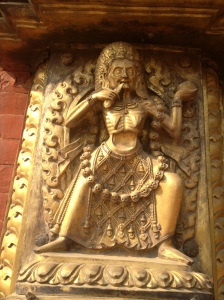
And here are a couple that capture secular life in the Kathmandu Valley.
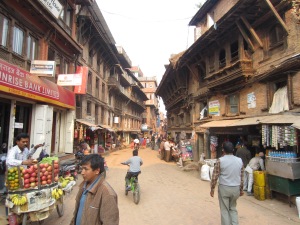
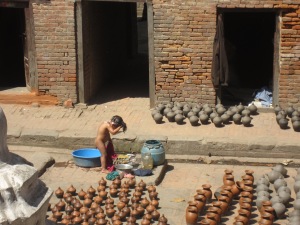
But notice the white stupa structure on the left side of the last photo under which this youngster is bathing.
B.P. Shresta: Getting it done in Dhulikhel
This is an entry about a man who has made a real difference in his community over the course of his lifetime, and who attributes his successes to a year spent in the United States.
We had the pleasure of meeting Mr. B.P. Shresta of Dhulikhel, Nepal during a two-day visit to his hometown set on the eastern rim of the Kathmandu Valley. We were introduced to B.P. by our family member, Dr. Jerry Bunker, who spent some time in Dhulikhel practicing medicine. “Bunker” (as B.P. fondly calls Jerry) and B.P. became friends and have maintained that friendship over the years and distances. We benefited greatly from the Bunker-B.P. connection when we contacted B.P. and were invited to spend time with him and his family at their hotel, the Himalayan Horizon, named for the magnificent mountain views from the rim of the valley. Clouds obscured the views most of the time we were in Dhulikhel, but meeting B.P. and hearing his story more than made up for the mountain-less scenery.
B.P., never before having left Nepal, traveled to Davis, California in the late 1960s for one year to teach the Nepali language to outbound Peace Corps volunteers. B.P. claims that while in the United States he observed a mentality, an approach to problem solving, and a “can do” attitude that contrasted sharply with what he grew up with in Nepal: an attitude of fatalism (his word). B.P. marveled at the freedom and defiance of the hippy culture and at other new ideas that were in the air including individualism, entrepreneurialism, and civic engagement. He also absorbed these ideas and transported them back to Dhulikhel where he returned after his year abroad. In the subsequent 45 years Dhulikhel has been the beneficiary of B.P. and his American experience. (B.P. claims it was his visit to the United States that set his wheels in motion.)
Upon his return, B.P., seeing that those same hippies were starting to visit Nepal and needed lodging, started a four-room guesthouse with no indoor plumbing. By the time we visited Dhulikhel, he’d built the Himalayan Horizon, a four-building compound with a conference center and 60 high quality guestrooms (the nicest we’ve stayed in on this trip). But B.P.’s commercial activities were only the beginning of his contribution to Dhulikhel.
A true visionary, B.P. has been able to see things both as they are and as they could be.
He started with a municipal water system. In the country with the second largest reserve of freshwater in the world, Nepal’s water distribution system is abominable. In the pre-B.P. Dhulikhel water was hauled in buckets up from the valley. In post-B.P. Dhulikhel a German-engineered water system brings water from a spring 14 kilometers to the south supplying the townspeople with water at the twist of a tap. Around this same time, B.P. began to engage in politics, serving as the mayor of Dhulikhel for 14 years.
During Bunker’s time in Dhulikhel, the absence of regular health care services was noted and quickly remedied by the establishment of a small clinic. It soon became clear that the clinic was not sufficient to fill the health care needs of the community and B.P. set out to organize and seek funding for the building of what now stands on the slopes of Dhulikhel: the state-of-the-art Dhulikhel Hospital. The service area for this hospital stretches across a quarter of the country, and it (along with the water system) has come to be regarded as a model for other communities in Nepal. Not only does Dhulikhel Hospital serve patients, but it is also a teaching hospital for the training of health care providers pursuing their degrees at yet another B.P. institution.
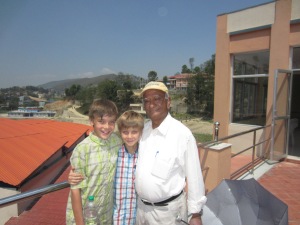
Yes, you may have guessed it, B.P. was also a primary mover behind the establishment of Kathmandu University: a 3,500 student, Dhulikhel-based university [despite the name] offering undergraduate and graduate degrees mostly in science and technology, areas specifically chosen to fill recognized gaps in the offerings at other universities in the country.
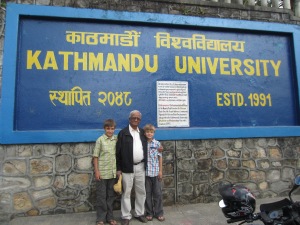
After Kathmandu University had been up and running for several years, B.P. realized that very few students coming out of the Dhulikhel secondary schools were being accepted to Kathmandu University. Those students were simply not prepared for college, the director of admissions told B.P. B.P.’s next stop was improving the elementary and secondary school system of Dhulikhel enough so that some of those students could advance to Kathmandu University. Not surprisingly, given his previous track record, B.P. succeeded again.
We toured several of B.P.’s favorite successes and enjoyed his stories of how they came to be and of what was next on his to-do list. His determination, perseverance and patience were impressive. For us, the important lesson was that with vision, commitment and follow through real change can be made, even in a country as poor as Nepal (per capita GDP approximately $600, lower than Haiti, slightly better than Afghanistan, but worse off than every other country in the world outside of Africa).
Thanks, B.P.!

Holi Moly!
We made it back to Kathmandu from our trek in time to celebrate Holi. To make a long, convoluted story short, Holi is a Hindu festival that celebrates the survival of a Vishnu devotee — Prahlada, son of the demon god Hiranyakashipu — and the death of the demon god’s sister, Holika. It is a boisterous, day-long event that involves throwing or rubbing colored powder on other celebrants, spraying water, throwing water balloons, and dumping buckets of water from rooftops on Holi participants below. It is a male mayhem in which few if any Nepali women participate, and the less wholesome among the celebrants take the opportunity to touch women (almost all foreigners) in ways they would not dare otherwise. It can be a bit intimidating to say the least. Nonetheless, we all survived it!

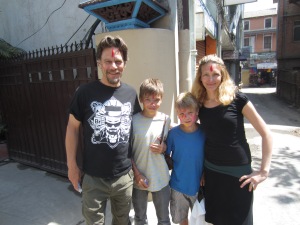
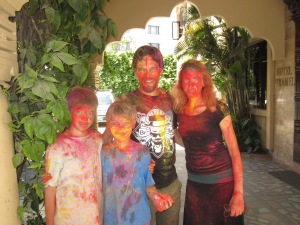
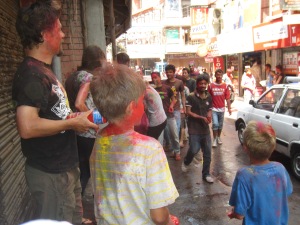
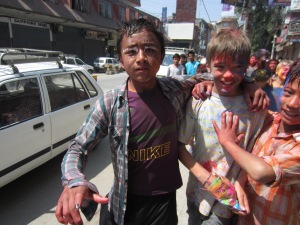

Trekking Langtang Valley and Gosainkund
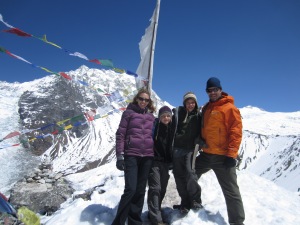
Opening with a family photo atop a snow covered peak surrounded by stunning mountain scenery is an irresistible gimmick. Sorry. Getting high into the Himalaya was one of the goals of this trek, but getting there and back made up the bulk of the experience.
Here you are either walking up or walking down, and the ups and downs are massive. Our 12-day trek started at the end of the road in the town of Syaprubesi (1500m x 3.3 = 4950ft) and took us up the Langtang Valley over the following five days to the settlement of Kyanjin Gompa (3900m) with a day trip to the nearby “hill” of Kyanjin Ri (4600m). The return trip took us back down the river to Bamboo (1950m) before heading back up through the relatively large (and uniquely electrified) town of Thulo Syaphru (2250m), the tiny two-house Foprang Danda and the beautiful views from Laurebina Yak (3900m). On our final day we descended from Laurebina Yak to the roadside town of Dunche (1900m) to catch a bumpy, windy, 6-hour jeep ride back to Kathmandu on roads with precipitous drops through switchbacks and landslides. For those of you doing the math, the last day’s descent was the equivalent of walking down from the peak of our highest east coast mountain, Mt. Mitchell (2037m), to sea level.
This is not a wilderness area, but a place lightly populated mostly by third-generation Tibetans. Religious objects are everywhere. Here are a few that we saw along the trail.

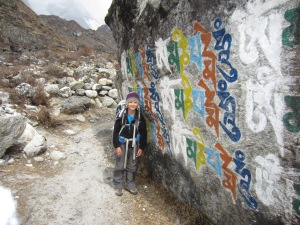
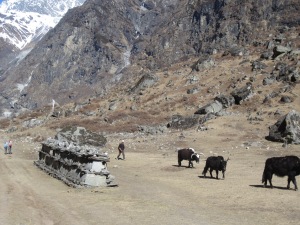
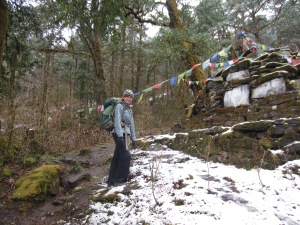
But not all of the religious objects were Buddhist. On the trail to the sacred Hindu lakes of Gosainkund, Shiva images start to appear.
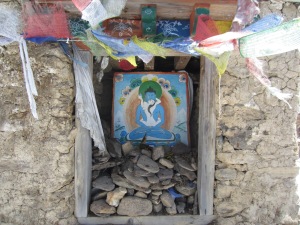
The trails themselves are much-used footpaths that have connected settlements for hundreds of years. This is a roadless area, so everything that moves here moves along these paths. That includes not only the people, but the goods. Pack animals carry cement, rice and other bulk items that are not likely to be broken when bashed against trees or rocks on a narrow trail. Humans are the pack animals for everything else. It was a painful and sobering sight to see men (young and old) hiking for three leg-trembling days (Syaprubesi to Kyanjin Gompa), often in flip flops, with the following items across their backs supported by a strap over the forehead. (Photographing these guys seemed too voyeuristic, so words will have to suffice.) Five 4×8 foot sheets of 1/4 inch plywood; 2×8 foot rolls of galvanized, corrugated sheet metal roofing material; reams of rebar; several cases of 750ml bottles of beer; solar panels, brackets, and piping for solar hot water systems; and the ubiquitous heavy-ass load of unidentified stuff to be consumed by trekkers somewhere further up the trail. A three-day haul with 90-150 pounds strapped to the back will bring in approximately $35. In Nepal this is big money; enough, apparently, to destroy your body getting it.
In addition to the lowly pack-animal porter hauling commodities up the trail, many trekkers hire their own personal porters to carry their gear so they can walk with a small day pack. The juxtaposition of doughy trekker with day pack against sinewy porter with three large backpacks strapped around his head and back was a tough one to see over and over again. We are used to carrying our own gear when we hike, and did so on this trek. But was that the “right” thing to do? As a result, we left at least one Nepali unemployed who would otherwise have made as much as $15-20 per day carrying our stuff. The porters we passed were not concerned about this dilemma and instead invariably commented with glee on the size of the boys’ packs. Some images from the trail.
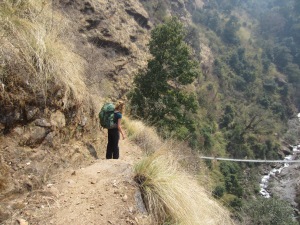
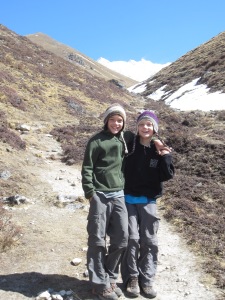
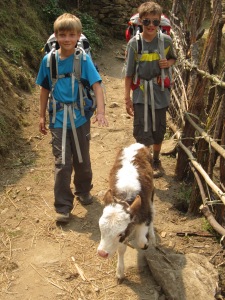
The day-to-day was what made the trip. We met great people along the way, both local hosts and international trekkers. We ate mediocre but filling, carb-heavy meals and drank lots of hot drinks. We enjoyed good weather almost all of the time. And we slept well after long days of intense exercise (except when sharing lodging with large groups of loud Koreans . . .). Here are some images that capture some of those experiences.
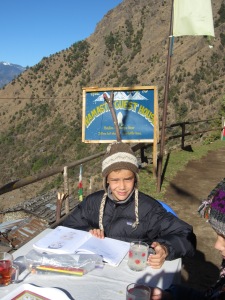
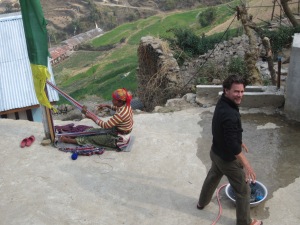
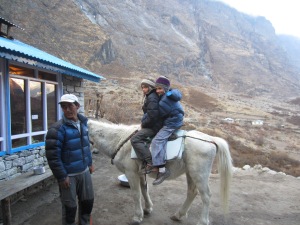
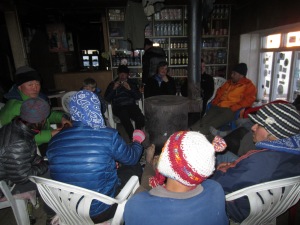
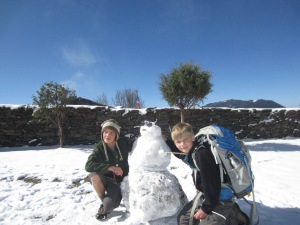
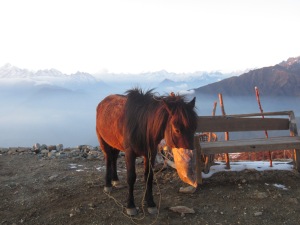
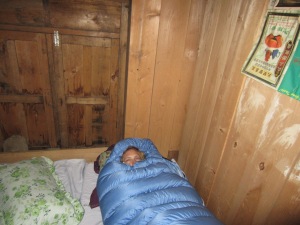
Every day on the trek was a good one, but the best one had to be the day that we set out from Thulo Syaphru on the way to Shin Gompa (an 1100m climb). It had rained the night before, which was an unusual weather event this time of year. The trails were a bit slick and the sky was still overcast. After an hour or so thunderheads started rumbling and we sought shelter where we could find it under the eaves of a storage shed. As we crouched there with the temperatures dropping and the rain increasing we received good information from a passing Nepali of a tea house ten minutes up the trail. We made a run for it and managed to reach the warmth and shelter just as the skies opened up. The next four hours were spent on benches around a wood burning stove with an American birder, a Canadian wanderer, two German medical students and their various guides and porters sipping tea, eating various combinations of noodles, rice and potatoes, and watching a pan on the stove fill with water dripping from the ceiling. It was heaven compared to the outdoor alternative. When the weather finally cleared we got back on the trail and continued our climb through slushy forests to the ridge top clearing of Foprang Danda. The two tea houses that usually serve as a lunch stop became our home for the afternoon and night, and Foprang Danda became our favorite trail moment. Our young host cooked up an excellent dinner and we slept hard and well crammed into a room no bigger than the bed itself oblivious to the rats sharing our space and unconcerned about the frigid outdoor squat toilet with the shower curtain door. Rising at 5:30AM we caught the clear morning views to the west, north and east as the sun rose to the sound of roosters and nothing else.
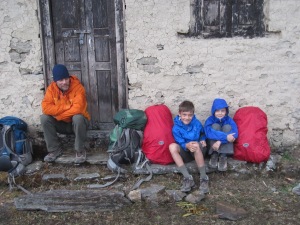
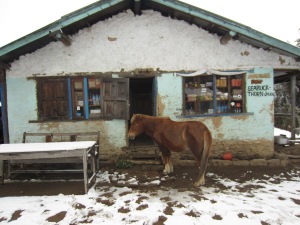

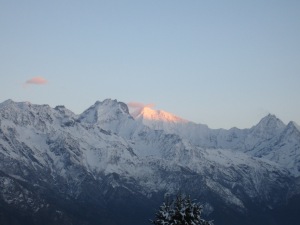
Happiness is trekking with your family on the rooftop of the world.

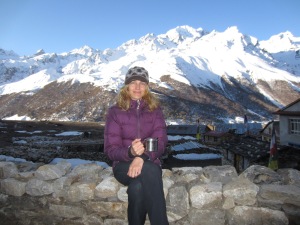
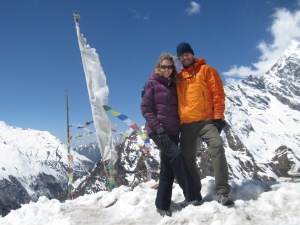
Life and death on the banks of the Bagmati River
The Pashupatinath Temple on the banks of the Bagmati River in Kathmandu is one of the most significant temples to the Hindu god Shiva in the world (and Nepal’s most important Hindu temple), and it happened to be a twenty minute walk from our guesthouse in Boudha. It also happened to be the day before the festival of Maha Shivaratri (“Night of Lord Shiva”) when devotees of Shiva (including thousands of ash-covered Sadhus) gather by the hundreds of thousands at Pashupatinath Temple (Pashupati is one of Shiva’s incarnations as “Lord of all Animals”) to make their offerings, bathe and anoint the Shiv Linga, and smoke marijuana. We figured we had to check it out.
The temple complex was already in full swing with about 12 hours to go before the official midnight start of festivities. As we entered with the throngs we were picked up by a near-toothless gentleman named Keshab Badal who became our guide for the day. Mr. Badal was quite an asset, as it turned out, presenting to us the basics of the Hindu belief system as we sat on the banks of the Bagmati overlooking the cremation ghats of Pashupatinath. This time of year the Bagmati is reduced to a sewage and plastic filled trickle as it makes its way from from the snow-covered Himalaya down to the Ganges across the plains of India. But like the equally polluted Ganges River, the Bagmati is sacred despite its current physical state. As Mr. Badal said “science says it is toxic, but culture says it is pure.” Believers who are near death are brought to a hospice building within the temple complex on the banks of this river to be near it when they die. This allows them to drink from the river just before they die in order to purify their souls, to be washed in the river after their death, and to be cremated on the ghats of the river shortly thereafter. As we sat with Mr. Badal listening to a cogent explanation of the Hindu trinity of birth, life, and death and the main gods Brahma (the creator), Vishnu (the preserver/protector), and Shiva (the destroyer/recreator), we witnessed all of the stages of this final life ceremony as the terminally ill were brought to hospice, as the bodies of the recently deceased were washed on the banks of the river, and as the shrouded bodies were placed on prepared piles of firewood, unwrapped for their final exit (“naked in, naked out” another Badalism) and set ablaze. The smoke from the ghats filled the air as dreadlocked, loinclothed holy men wandered by.


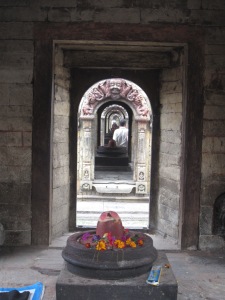
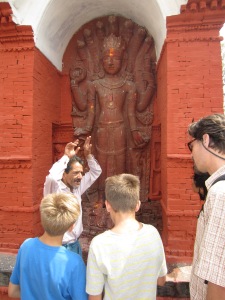
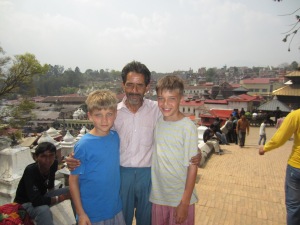
Nepal, “the best country so far”
The boys declared Nepal the best country so far within an hour or two of landing in Kathmandu. When asked to specify what made it the best country, their answers varied from the vague “I don’t know, it’s really cool” “everybody’s really open and nice and stuff” to the more specific “the tea” “the colors, sounds and smells” “the sadhus”. I have to agree with them, but I am also hard pressed to put the “why” into words.
If only one word was allowed, it would be “texture”. That might be a stand in word for “what a place looks like when it is extremely poor”, but there are other extremely poor parts of the world that don’t have this feel. Nepal is an unthreatening place, even (apparently) for a nine year old boy. It is a place of stunning natural beauty (which we’ve so far only caught a glimpse of from the plane window). It is a place of vibrant culture, much of it intertwined with two of the most fascinating world religions: Hinduism and Buddhism. It is a place that seems totally chaotic, but in a good, exciting and energizing way. We’re all looking forward to our two months here.
It did not hurt the first impression of Kathmandu that we decided to stay in Bodhnath (or Boudha) on the good recommendation of our friends Kevin and Sarah. Boudha is the home of Asia’s largest Buddhist stupa and is inhabited primarily by Tibetan refugees. Our first afternoon in the country was spent circumambulating the Bodhnath Stupa with the maroon-robed monks and other devotees under fluttering prayer flags with the scent of yak butter candles in the air. Among the many people who took an interest in boys (but who could not care less about the boys’ parents) were two newly minted nursed who wanted to practice their English. The boys have enjoyed celebrity status throughout the trip, but Nepal has brought it to a new level.
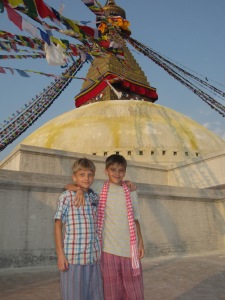
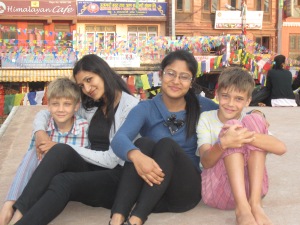
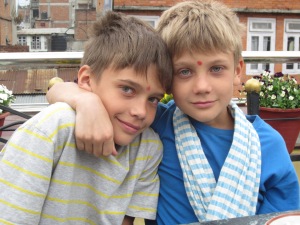
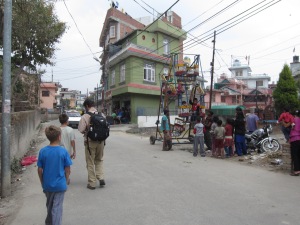
Bangkok
We’ve been enjoying the life of luxury in Bangkok; a big, crowded, hot and humid SE Asian capital city. Our home has been the Four Points hotel on Sukhumvit Soi 15, a high end district of Bangkok, paid for on points. The free shelter has been accompanied by perks like 2 for 1 drink specials at the rooftop pool bar complete with a buffet robust enough to feed this family of four, and free wi-fi in the lobby. In other words, we are acting like backpackers, but living like five star tourists. The AC, reliable electricity and hot water, the fast internet, the concierge desk, pool, cable TV and etc have been really nice and potentially addictive. We will wrench ourselves loose from this paradise tomorrow when we fly to Kathmandu for two months in Nepal.
During our stay here, we’ve done a couple days of urban adventure that have included a stroll to the largest shopping mall in Asia and a day riding the SkyTrain and Chao Praya river taxi to the old backpacker center of Khao San Road, the Royal Palace, and Wat Pho (home of a huge reclining Buddha with beautiful mother-of-pearl inlaid soles).

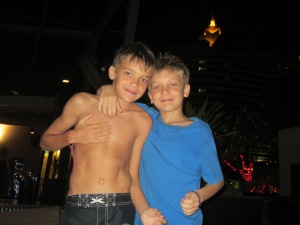


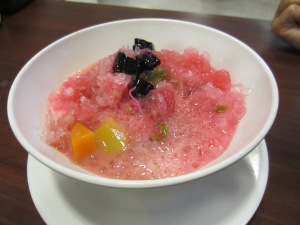
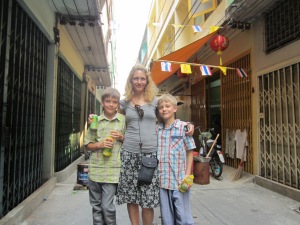
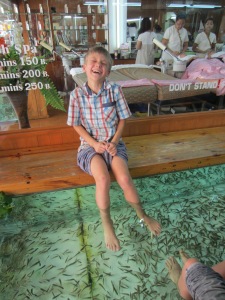

Kampot, Cambodia
Next stop, Kampot on the southern coast of Cambodia, a quiet, riverside town best known for its eponymous Kampot pepper. We had a very peaceful and relaxing few days at the Ganesha eco-resort, a much needed change of pace after so much urban sightseeing. We rode bikes, canoed through the mangroves, napped, played cards, enjoyed the warmth and quirkiness of our lovely French hosts, and stressed over which of the many hammocks, hanging beds and relaxing spots to choose from… so many, so little time. We had our hands-down best lodging of the whole trip… a three story circular stone tower with hammocks and panoramic views of the surrounding rice paddies and distant Bokor mountains on the third floor (this became boy headquarters and yoga central). As long as you don’t mind sharing your bathroom with frogs and your bedroom with large geckos, waking to 5 a.m. Call to Prayer at the neighboring mosques, and spirited Cambodian weddings with loud PA systems that pulse with music all night on weekends, you will love Ganesha. And we did!!!!




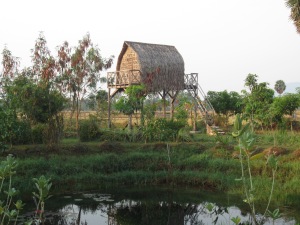
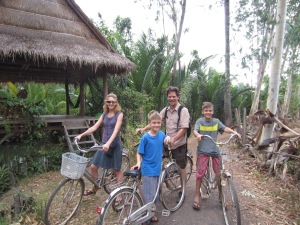

Tuk-tuks
We have spent a great deal of time getting around cities in tuk-tuks. It is a great way to see a city and to experience the chaos of the urban landscape. Here are a few photos. I have found it is best to sit on the bench that faces away from the driver and the oncoming traffic. This helps when, for example, you are the only vehicle going in completely the wrong direction around a very busy city rotary.

